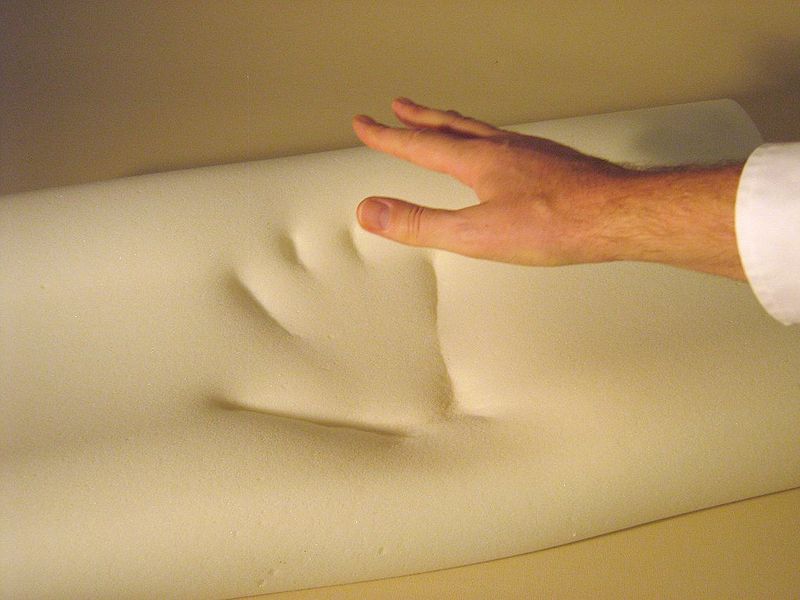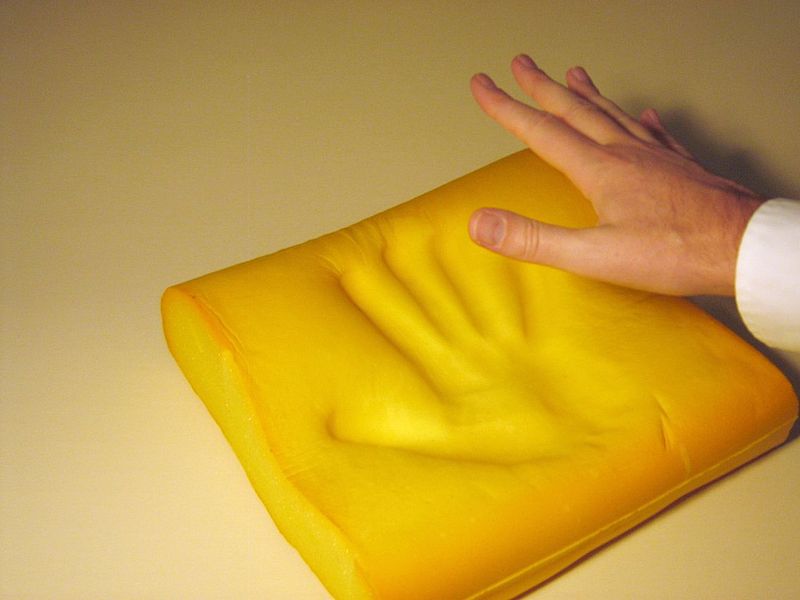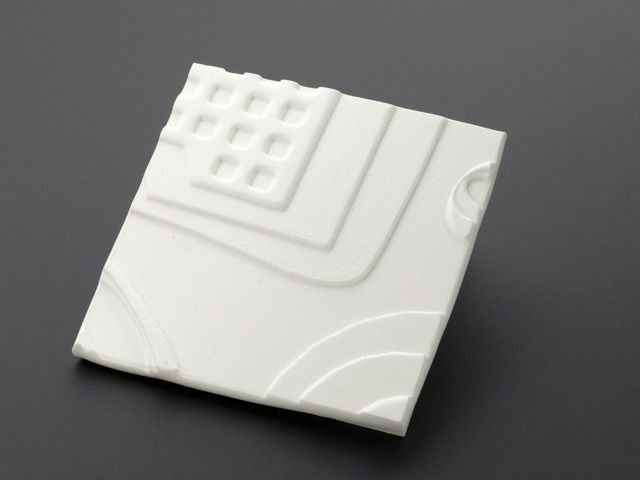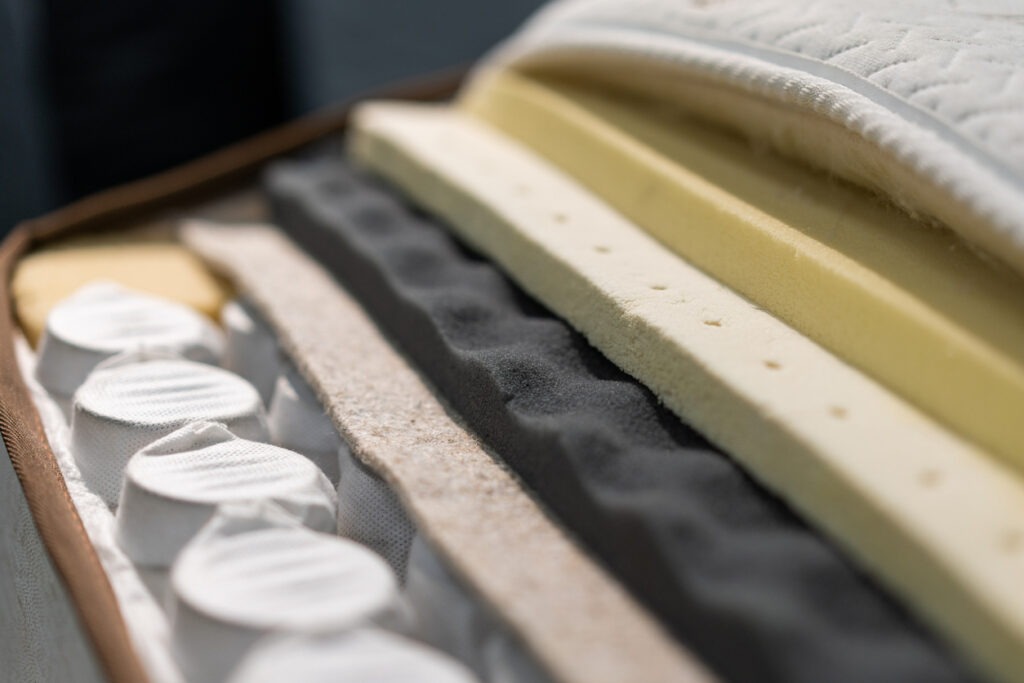Memory foam has emerged as one of the most well-liked mattress materials, and if you’ve recently been looking for mattresses, you’ve undoubtedly heard the term “memory foam.”
Memory foam that absorbs shock and relieves pressure was first developed in the 1960s for NASA spaceship seats and seatbelts. It is also used in wheelchair sitting pads, prosthetics, and shoes. But memory foam wasn’t made popular as a mattress material until Fagerdella World Foams introduced their Tempurpedic Swedish model in the 1990s. Since then, the demand for memory foam mattresses has blown up, mostly as a result of the rise of mattress-in-a-box businesses.
But what is memory foam exactly? What are its components, how does it function, and how can you tell if it’s the best option for you?
We have your back. We’ll explain the ins and outs of memory foam, how it’s used in mattresses, and a guide to the different types of mattress technologies.
What is Memory Foam Made of?
Memory foam is mostly made of polyurethane, a material having big molecules made of numerous small, identical subunits joined together. Polyurethane, a very common and versatile plastic polymer, is used to make a wide range of products, including insulation, liquid paints and primers, spray foam, elastic fibers, automobile parts, and even strong elastomers like roller blade wheels. Furniture like sofas and mattresses are just two examples.
Low-resistance polyurethane foam (LRPu) or “viscoelastic” polyurethane foam is the term used to describe memory foam. It is produced by mixing several substances and additives with polyurethane, which vary according on the type of foam being produced.
In the end, these substances have an impact on the viscosity and elasticity of memory foam, two of its key characteristics. When we refer to a substance as “viscous” in the context of memory foam, we indicate that it takes a long time to change shape under pressure or to transmit energy from one location to another. A material is said to be “elastic” if it can stretch or twist but returns to its original shape or size when the force that caused the stretching is removed.
Different manufacturers use different “recipes” for the chemicals they add to the foam and the methods they use to create the foam. These compositions and procedures, which are typically private secrets, affect how each memory foam product feels and functions. However, a material known as polyether polyol is often present in the viscoelastic foam used in the majority of memory foam mattresses, which helps to increase the foam’s elasticity and viscosity.
How Does Memory Foam Work?
Memory foam mattresses, as we discussed above, are made to gradually mold to the body in reaction to pressure, equally distributing body weight. They are also designed to be strong and return to their former shape after being freed from human weight and strain.
When it comes into contact with your body heat, memory foam softens, fits to your individual curves, and evenly distributes your weight. Depending on how much pressure or “force” you exert, the material reacts differently. Memory foam is great at absorbing the force of an impact, which is why it was initially utilized in fields like space shuttle construction. If you apply pressure quickly, the foam tends to alter shape more slowly, or “reluctantly.” This memory foam property, used to make mattresses, helps the mattress cushion the body equally and produces the gradual contouring effect as the mattress adjusts to your body’s impact and re-forms around your curves.
Additionally, memory foam takes a while to return to its normal shape after being forced—on average, 5–10 seconds. Energy from the hit is absorbed and lost during this interval of recovery. Sleepers benefit from this “hysteresis” occurrence because it lessens the pressure (or impact energy) created by the prone body.
The fact that memory foam loses viscosity as temperature rises is another crucial aspect of how it functions. This implies that when the temperature rises, it becomes less rigid and more flexible. Since your body heat raises the temperature of the sleep surface, this is why memory foam mattresses seem softer or more flexible after you’ve been resting on them for a while.
Different Types of Memory Foam Mattresses
There are many different sizes, forms, and construction types of memory foam mattresses. There are several fundamental forms of memory foam, in addition to the specific variations in chemicals and manufacturing techniques for each individual foam product.
Types of Memory Foam
There are primarily three categories of memory foam:
Traditional
This is memory foam in its original, “classic” form. It was the first type of memory foam to reach the consumer market. Traditional memory foam is made in the manner described above and is designed to react to your body. Traditional memory foam has the drawback of having the propensity to hold onto heat, which can make the sleeping surface of mattresses made with such foam uncomfortable. The two additional varieties of memory foam were developed in part to deal with that difficulty.
Open-Cell
The same components as typical memory foam are present in open-cell memory foam, but it has a different interior structure. Memory foam mattresses with internal “open cells” or pockets allow for ventilation and air flow, which helps the mattress disperse heat.
Open-cell memory foam mattresses were initially much less dense, which occasionally had an impact on the firmness and made them seem less supporting. New manufacturing techniques have been created to solve that problem while simultaneously maintaining the mattress’ open-celled structure (and, thus, its cooling effect).
Gel
Another variety of memory foam includes gel in the manufacturing process. Gels are typically added to mattresses by injecting foam with gel-based microbeads. The pockets that are produced by these microbeads resemble those found in open-cell mattresses. These gels are typically “phase-changing” polymers, which means they actively absorb and release heat from your body, as opposed to just letting air through the mattress.
While some mattresses only use foams that fall into one of these categories, many contemporary memory foam mattresses use foams that fall into two or even all three categories.
Some memory foam mattress manufacturers now add other materials to their mattresses in addition to these three fundamental types, frequently with the goal of cooling. Copper is one of such materials. When utilized in memory foam mattresses, copper’s high conductivity aids in moisture wicking and heat dissipation. All three of the major varieties of memory foam have mattresses that fulfill the bill that use copper in their manufacturing.
The creation of more environmentally friendly foams is another emerging breakthrough in memory foam. Compared to the typical memory foam mattress, these eco-friendly memory foams (also known as “greener memory foams”) contain more plant-based components. For instance, they might employ soy or maize oil-based components and derivatives in place of some petroleum-based compounds and derivatives used in the production of conventional memory foam. Although these manufacturing methods are still quite new, they are spreading as technology advances.
Mattress Construction
Mattresses employ memory foam in a variety of ways. One difference between memory foam mattresses is their various structures, each of which is intended to attain a particular quality. Even if the special elements vary, most memory foam mattresses adhere to a similar structure. There are three parts to that template:
- Comfort Layer – Depending on the stiffness of the mattress, this top area is made up of one or more foam layers that are often intended to give contouring and cushioning. In order to keep heat away from the sleeping surface, this area of many mattress designs uses more breathable foams.
- Transition Layer – One or more foam layers make up this area of the mattress, which serves as a transition between the comfort layers and the core. They frequently aid in wicking heat away from the comfort layer and are typically slightly stiffer than the foam in the comfort levels.
- Core – This serves as the mattress’s foundation. It is normally the top layer by a significant margin and is frequently made of foam that is much stronger. The other foam layers help to stabilize and support the mattress. The core of some mattresses, referred to as hybrid mattresses, is not foam but rather is similar to the core of an innerspring mattress. This typically offers more support, bounce, and ventilation.
Qualities of Memory Foam
Now that we are clear on what memory foam is, let’s discuss how it feels and what it’s like to sleep on a memory foam mattress. Although various mattresses will offer a variety of each, memory foam mattresses usually have three basic characteristics.
- Contouring – Right there in the name is one of memory foam’s distinguishing qualities. On a memory foam mattress, you can feel the sleep surface conform precisely to the curves and angles of your body as you are lying down.
- Sink – Memory foam has a tendency to “sink”—that is, to give the impression that you are being embraced by the mattress and may even be sinking down into it—in addition to contouring.
- Palpable Response – When you lie down, the material will respond to the heat and pressure of your body by becoming more flexible and less slippery since, as was already said, memory foam is very pressure-adaptive.
Memory Foam Pros and Cons
Memory foam mattresses have a number of unique qualities, some of which make people enjoy them and others of which might turn them off. Not everyone likes how flexible memory foam feels; in fact, some people find memory foam to be downright unpleasant. Extreme softness, a limited capacity to control temperature, and a strong initial off-gassing smell are some of memory foam’s problems.
To answer both widely mentioned advantages with concerns while discussing memory foam, it is essential to address both of them.
The Pros
Provides Pressure Relief
Memory foam molds to the body, taking into consideration the pressure and heat generated by your own body. This may offer a reduction in the hips, shoulders, and neck, which experience the most pressure as we sleep. Regular, disproportionate pressure on particular body regions can interfere with falling and staying asleep and result in pain when you wake up.
Memory foam’s contouring properties can help some people, especially those with joint problems or arthritis, experience less pain and discomfort by distributing weight evenly and relieving pressure on typical pressure points.
Promotes Spinal Alignment
The contouring abilities of memory foam also benefit many sleepers by promoting proper spinal alignment and offering lumbar support. When a surface adheres to your body’s natural curves, like memory foam does, it may be easier to find sleeping positions that maintain your spine in neutral alignment. You may prevent morning pains, back discomfort, and nighttime tossing and turning by doing this.
Hypoallergenic
One key advantage of memory foam mattresses for allergy sufferers is that they typically have a hypoallergenic composition. Memory foam mattresses are less prone to draw in and collect allergens like dust mites, mildew, and other common irritants due to their dense structure.
Reduces Motion Transfer
When choosing a mattress, it’s crucial for co-sleepers and couples—especially those who are light sleepers—to make sure you won’t be able to feel your spouse move or get up during the night.
Memory foam provides a big advantage if keeping motion transmission to a minimum is important to you. Memory foam does a superb job of preventing motion on one region of the bed from being sensed on another because of its density and the way it responds to and distributes pressure.
Quiet
Another significant quality of memory foam mattresses is their quietness. Couples who don’t want to wake up their partners while getting out of bed should consider this, as should anyone who doesn’t want to be bothered by the squeaking, groaning, or other noises that can emanate from a very noisy bed.
View this post on Instagram
The Cons
Heat Retention
One of the primary issues with memory foam mattresses is its ability to retain heat and get quite warm. Due to the density of the material and the way that memory foam, particularly traditional memory foam, reacts to body heat, it can get more warm.
Although memory foam technology has created open cell and gel foams as well as other cooling construction techniques to address this issue, they still have a tendency to retain heat more than other types of mattresses. This could make it hard for you to get to sleep and stay asleep if you already have a hot sleeper’s condition.
Cost
The price difference between memory foam mattresses and conventional mattresses is another disadvantage. This is especially true if you get a memory foam mattress of exceptionally high quality. Memory foam mattresses are typically more expensive than innerspring mattresses of comparable grade.
The average price of memory foam mattresses has decreased as they are increasingly widely used, particularly as mattress-in-a-box businesses gain popularity. It is still, by far, the most expensive choice.
Not Waterproof
Water and moisture in general can harm memory foam mattresses, as well as memory foam toppers and pillows. Liquids can shorten the life of a memory foam mattress by degrading the foam. If you live in a region with high humidity or have a young child or pet who is prone to spills or accidents, this is especially annoying. A memory foam mattress is particularly difficult to clean because of this.
“Stuck” Feeling
Some people discover that the memory foam feel might make them feel trapped or sucked up into the material because they sink too deeply into the mattress. This can make it more challenging to walk around at night, and some people may simply find it unsettling or unsettling in general. People who are particularly bothered by the sinkage of a memory foam mattress will only grow to resent it more as the mattress gets older.
Off-Gassing and Odors
Memory foam mattresses frequently have a distinct, chemical-like fragrance when they are first made. This is known as “off-gassing,” and it often goes gone within 24 hours of being unboxed, though occasionally it might linger for weeks. Cheaper memory foam mattresses have stronger and more persistent off-gassing.
Heavy/Difficult to Move
Many memory foam mattresses now come in mattresses in boxes, giving the impression that they are lightweight. This isn’t typically the case, though. A memory foam mattress is typically much heavier than other types of mattresses after it is set up.
When trying to lift the mattress to change the sheets or move the mattress, this could be problematic. Moving can also be extremely difficult, especially when it involves a mattress in a box because it will probably be much more difficult to remove the mattress from the room than it was to get it in.
View this post on Instagram
How to Pick The Right Memory Foam Mattress
There are still a lot of things you should be aware of while shopping for the ideal memory foam mattress match even if you’ve chosen that memory foam sounds like the best option for you. Here are some general guidelines for selecting a memory foam mattress.
Firmness
There are numerous firmness options available for mattresses. The basic description of mattress firmness uses a scale from extremely soft to very firm, which is frequently expressed numerically between 1 and 10 (very soft to very hard). Consider it a more complex version of the story of Goldilocks and the Three Bears: some individuals prefer their mattresses to be quite hard, while others prefer them to be extremely soft.
Most mattresses will be classified as falling somewhere on the soft-firm spectrum in-store or online. You can search for an Indentation Load Deflection (ILD) rating, but, if such information isn’t provided or isn’t sufficiently detailed. In essence, this is a measurement of firmness; the higher the ILD rating, the firmer the mattress should be. ILDs are rated in such a way that each layer of the mattress, such as the comfort, transition, and support layers, has a separate ILD score, and the mattress as a whole has an overall ILD score. A mattress with an overall ILD of 10 would be very soft, while one with an ILD of 50 would be quite firm, according to the ILD scale. Use those criteria to evaluate things if you desire 9
The amount of actual foam that is incorporated into each layer of memory foam determines the mattress’s density. The density of memory foam is measured in pounds per cubic foot (PCF), and it ranges widely. In general, the foam will retain its shape, elasticity, and support structures for a longer period a higher its density. But higher-density foams also typically cause you to sleep hotter.
A decent density that balances lifespan and heat retention for average-temperature sleepers (those who don’t become overly warm at night) is between 3.0 and 5.0 PFC.
Thickness
The thickness of a memory foam mattress is determined by how many inches it is measured from the side. In contrast to density, the ILD score for three inches of foam may range from 10 to 50. Mattresses made of memory foam can be anywhere between 6 and 14 inches thick. Generally speaking, thicker mattresses are more supportive than thinner mattresses and, depending on the mattress, might also be softer.
You should take into consideration the thickness of each level in addition to the thickness of the mattress as a whole. If there are at least four inches of comfort and transition foam mixed between the sleep surface and the mattress base, memory foam mattresses perform best. This makes it possible to receive the support core’s advantages without the mattress becoming unpleasant.
Standardized Testing Certifications
Mattresses made of memory foam of inferior quality may contain additives that shorten the mattress’ lifespan, cause itching, and/or release fumes that may be hazardous to health. A Certipur-US accreditation should be something you keep an eye out for when selecting your mattress. With this certification, you can be sure that the memory foam in the mattress was created without any chemicals that can be bad for your health or the mattress itself.
Mercury, lead, heavy metals, and formaldehyde are not used in the production of mattresses that have received the Certipur-US accreditation. Additionally, they are made without phthalates (plasticizers that may be damaging to reproductive health) and PBDEs (polybrominated diphenyl ethers), a flame retardant that is prohibited in the US due to its detrimental effects on health but is occasionally used in the production of mattresses abroad. Additionally, these certified mattresses contain less volatile organic compounds (VOCs), which are the principal culprits behind the chemical odor that results from off-gassing.
It is worthwhile to find out if a mattress is certified before making a purchase decision because choosing a mattress with certified foam reduces your stress when it comes to the quality, longevity, and safety of your mattress.
Conclusion
Memory foam is a unique material in the field of comfort and support due to its extraordinary qualities and mechanisms. Due to its viscoelastic properties, it may respond to heat and pressure, taking the contour of your body and dispersing your weight equally. Memory foam’s temperature sensitivity ensures a custom fit by conforming to your body’s contours and encouraging optimum alignment. Furthermore, a more restful and undisturbed sleep experience is facilitated by memory foam’s capacity to absorb motion transfer and gently restore its shape.



